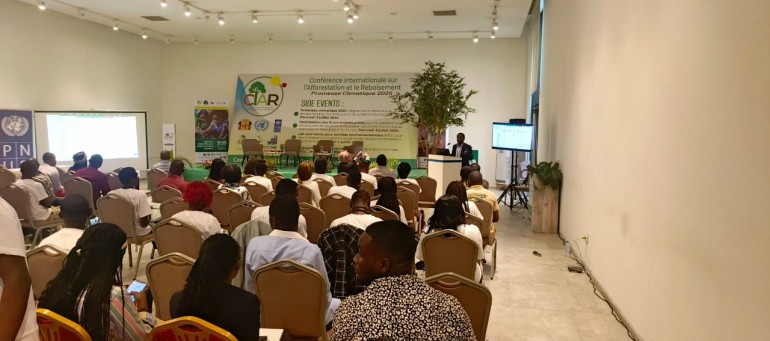

26.07.2024
From July 02 to 05, 2024, in the Republic of Congo, the 1st International Conference on Afforestation and Reforestation (CIAR1) was held. CIAR1 defined a strategy aimed at increasing the world's forest area on the basis of international cooperation through the systematization of afforestation and reforestation activities.

The aim of this strategy is to (i) increase atmospheric carbon sequestration capacity to combat climate change, (ii) preserve habitats and biodiversity and (iii) support and/or maximize the production of goods and services provided by forests.
It is in this context that ATIBT presented its innovative reforestation project in the Unités Forestières d'Aménagement du Cameroun (UFA-REFOREST), which is in line with the objectives of CIAR1. Focused on reforestation, the UFA-REFOREST project contributes to restoring forest cover and maintaining populations of commercial species in the Management Forest Units of four forestry companies in Cameroon: AlpiCAM-GrumCAM, PALLISCO, SEEF and SEFAC.
The UFA-REFOREST project contributes to achieving the objectives of the Programme d'Amélioration de la Gouvernance en Milieu Forestier (PAMFOR), of the Programme Indicatif National (PIN) of the 11th European Development Fund (EDF) of Cameroon. It is financed by the European Union, implemented by ATIBT, with technical support from Nature+, Gembloux Agro-Bio Tech and ENSET of the University of Douala.
Two side events were organized during the conference on the following themes: (i) enrichment of felling gaps and full planting in Cameroon's Unités Forestières d'Aménagement and (ii) long-term monitoring of plantations in felling gaps in these Unités Forestières d'Aménagement.
At the first side event on July 2, 2024, Yanick NKOULOU, head of the UFA-REFOREST project, presented the activities carried out in the field. He spoke of the collaboration between the various players and the project's beneficiaries, notably local communities, the forestry administration and the private forestry sector. At mid-term, the plantation project has achieved 68% of its objectives. Several regulatory incentives have been introduced to promote reforestation in Cameroon.
At the second side event, the preliminary results of long-term monitoring of plantations in felling gaps were presented on July 4, 2024 by Crispin ILUNGA-MULALA, a PhD student at the University of Liège, Gembloux Agro-Bio Tech faculty. This research identified the species with the best survival and growth performance in felling gaps, in the Unités Forestières d'Aménagement managed by the Pallisco company in south-east Cameroon. Fifteen species were planted in felling gaps and monitored for up to 19 years. Fraké (Terminalia superba) in particular showed better survival and growth performance in the gaps. Three other species, moabi (Baillonella toxisperma), tali (Erythrophleum suaveolens) and mambodé (Detarium macrocarpum), also performed well. These species have been recommended for the enrichment of felling gaps.
The full presentation can be found here.
Improving knowledge of which species perform well in gaps would help maximize plantation yields, by avoiding planting species that are not suitable for gaps. As environmental conditions vary from one site to another, further research is needed on other sites to generalize these results. This research shows the importance of involving scientists in reforestation activities.
Several reforestation players, including ministers, particularly stressed the need for collaboration between scientists and forestry players at CIAR1.